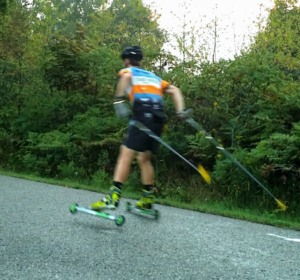By Alex Vanias, Team OAM Now Multi-Sport Athlete
Cross country skiing is often considered one of the toughest sports. It is aerobically demanding and requires continual explosive movements. As you can imagine, doing repetitive single-leg squats while doing pseudo ab crunches to push the ski poles can be very fatiguing over time. In addition to the physical demands, technique is crucial to skiing. The most fit athlete does not necessarily win ski races unless they have efficient technique. It becomes increasingly difficult to maintain proper form when fatigue sets in. This is why it is important to train for skiing in the summer.
I don’t do structured workouts for skiing in the summer, but I try to ski 2-3 times per week. This is primarily to maintain my technique and sport-specific efficiency for skiing while I am building fitness by riding and running. As a multi-sport athlete, I do not spend a lot of time on off-season training since I am training and competing in summer sports. However, because maintaining technique in skiing is so important, I do prioritize fitting in summer rollerski sessions.
 You may be wondering how somebody can ski in the summer. Well, there are these sketchy contraptions called roller skis. These are essentially long roller blades with a wheel on each end and a ski binding mounted to them. Regular winter boots fit into the bindings, although lighter and cooler ski boot models are available. I use regular ski poles but replace the baskets with special roller ski tips. The tips are carbide and need to be sharpened with a diamond file roughly every 50mi so they bite into the pavement.
You may be wondering how somebody can ski in the summer. Well, there are these sketchy contraptions called roller skis. These are essentially long roller blades with a wheel on each end and a ski binding mounted to them. Regular winter boots fit into the bindings, although lighter and cooler ski boot models are available. I use regular ski poles but replace the baskets with special roller ski tips. The tips are carbide and need to be sharpened with a diamond file roughly every 50mi so they bite into the pavement.
One of the biggest challenges of rollerskiing is stopping. Rollerskis generally have no brakes, so stopping safely takes careful practice. The wheels and bearings are not made for speed since they are intended to mimic the speed of skiing on snow. I generally average about 10-13mph on a normal ski, but can reach speeds of over 30mph on downhills. Because of the speed and difficulty stopping, I always wear a helmet; all it takes is a pebble or crack in the road to send me through the air. I make sure to scout out the roads I plan on skiing to make sure there are no stop signs at the bottom of hills and there is an appropriate shoulder and low traffic. There are many suitable areas for rollerskiing in northern Michigan, but it becomes more challenging in more populated areas. The US Ski Team (sarcastically) explains some various rollerski stopping techniques here.
Rollerskiing is a quirky activity, but it is a valuable component to my training. Juggling the demands of multi-sport training can be tricky, but varying my sports and training make me a better athlete and help me improve in each individual sport. In addition, challenging different muscle groups helps keep me injury free. I understand the importance of sport-specific training, but I think that many people underestimate the value of variation in training and racing.
Overall, I’m excited to start to ramp up my running and ski-specific training this fall for hopefully my best ski season yet!










